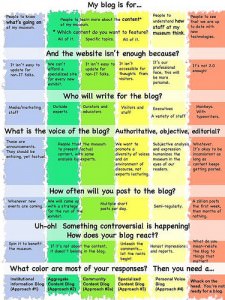In my last post, I introduced the editorial calendar as a business tool for bloggers. This week I’m answering all of your questions regarding the creation of editorial calendars and will take you step by step through a process that has proven to be useful in creating these documents. Properly setting up your calendar will help ensure that you and your blog posts have all the components for successful search engine optimization. A calendar can be set up to track daily, weekly or monthly posts depending on your desired web presence, and there are multiple templates available if you need a good starting point.
Creating your own template is simple. You will need to ask yourself a few questions to determine which tabs will be effective for your own goals – the classic who, what, when, where, why and how questions:
Tips for Creating Your Editorial Calendar
Who: Who is your intended audience and who will benefit from the topic and/or post?
What: What is the new content you plan to produce to satisfy your desired topic? You want blog post to be interesting to read and finding topics that will have enthralling readability among your audience is very important.
When: When is the best season to post new content for that specific topic? Find ways to correspond your brainstormed topics with a time of the year or event that is relevant.
Where: Where do you plan on hosting your new content? Will it be featured on any other websites or resources to increase views or will it remain privately featured on your own site?
Why: Why is it important for your readers to have this new content? Knowing your demographics and understanding what interests your readers will make this an easy question to answer. For example, if you are blogging about fashion and your readers are self-proclaimed fashion followers, then a series of blog posts about fashion week recaps would be important to them.
How: How will the success of each post be measured? This can be different for every post or can be a universal goal for your blog in its totality. Examples include new comments, Facebook likes, email newsletter subscriptions and analytical improvements in click through traffic or blog following.
The answers to the previous questions will provide you with tab topics that will be uniquely essential to your planning process. Your editorial calendar could include tabs with your post date, post topic, categories and tags, tentative post titles, keywords, call to action and posting status among many others. You may also find it useful to use hyperlinks in your spread sheet to link topic research and supplementary materials for constructing the blog posts.
These simple steps may seem time consuming, but in the long run the effective creation of an editorial calendar will reduce writer’s block significantly, will help identify opportunities and will help you track the progress of your blog and the effectiveness of your strategy.
Special Offer: Three Girls Media & Marketing Inc. loves working with small and emerging companies to raise their brand awareness and name recognition. We offer a complimentary 30-minute phone consultation. Emailinfo@ThreeGirlsMedia.com to make your appointment today!

